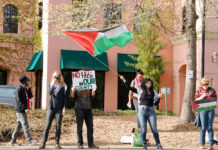— Rollie Atkinson
The horrific gang rape of a 15-year-old girl in a dark corner of
her Richmond (CA) school campus on the night of her homecoming
dance continues to send shock waves through many communities and
across the country.
For more than two hours as the young girl was attacked, beaten
and repeatedly raped, a crowd of fellow students and other
bystanders watched, took cell phone pictures and did nothing to
stop the violence.
“Can it happen here?” is an obvious question we want to ask
ourselves. We asked that question 10 years ago when the Columbine
High School massacre happened in Colorado. “Are our schools and
children safe?” Does living in our smaller, more affluent
communities make us immune from the larger social trends of
violence, insensitivity or numbing mob mentality?
This year’s high school homecoming season was very safe and
enjoyable for all. School officials are very practiced in keeping
our local campuses safe and secure. Security guards were hired and
added police support was on standby. Campus life since Columbine
has changed forever. What lessons we learn from the more recent
Richmond case remain to be seen. Gang rape is a repulsive crime.
But what do we call watching it for entertainment? If we call
rapists monsters, what do we call the others?
“Please do not respond to this tragic event by promoting hatred
or by causing more pain,” the mother of the young rape victim has
said. “Work toward changing the atmosphere in our schools and in
this community so that this kind of thing never happens again.”
That kind of work has been going on in our local schools for
some time with the Safe Schools Ambassador program led by
Sebastopol-based Community Matters. Budget and staffing cuts
continue to add new challenges to the daily work of educators but
student leadership programs, peer-to-peer counseling and “diversity
awareness” programs remain intact. Indeed, work to “wake up the
courage” in our students is taking place. More needs to happen.
Beyond the school campus lies a field of virtual multi-media
landmines of glorified drug use, televised sex (even rape),
simulated video game violence and vulgar song lyrics. Together
these vivid images and messages make up the background and
soundtrack to the gang rape scene where bystanders take photos and
share them with “friends.”
“We believe our kids know right from wrong,” said Rick Phillips
of Community Matters, “but knowing something is wrong and then not
doing anything about it is not OK.”
Phillips, who has worked in many schools after Columbine-like
violent incidents, believes there is a “consciousness crisis” in
our country. For many reasons attributed to our media-blitzed,
over-stimulated society, Phillips says too many of us of all ages
have become “disconnected” and “de-sensitized.” He calls it
“bystander-itis.”
Unhealthy social and emotional conditions that led to the
Columbine massacre are not any better today, Phillips said he
believes. “What has improved is an openness and a willingness for
educators and others to work on the problem. We are realizing now
that you can not legislate kindness or punish someone into being
good.”
Where there is computer-based social networking, there is also
anti-social networking. The phenomenon of cyber-bullying and
invasion of privacy has spread with the faceless communications of
Facebook, MySpace, Youtube and others.
It turns out that the way we talk to one another often
determines how much we respect one another. Peer pressure can be
both a very good and a very bad thing.
This is how we teach each other what’s right and what’s wrong.
What’s wrong is what happens when everyone becomes a bystander. The
right thing happens when at least one of us has the courage to
stand up.
50.7
F
Healdsburg
April 18, 2025







